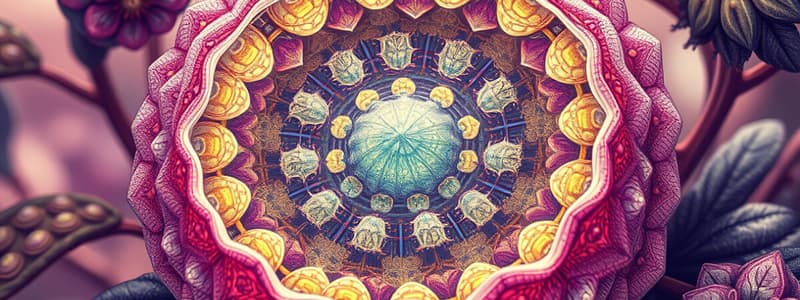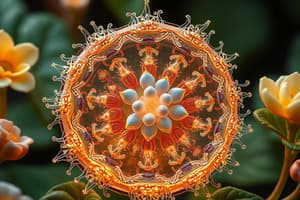Podcast
Questions and Answers
What is the structure of a chloroplast?
What is the structure of a chloroplast?
It's surrounded by a double membrane, inside is a fluid filled region called the Stroma and stacks of membrane called grana.
What are grana?
What are grana?
Known as thylakoids, contains pigments, and is responsible for the absorption of light energy.
What is the stroma?
What is the stroma?
Part of the chloroplast that contains enzymes which control the reaction of the carbon fixation stage.
How are thylakoids arranged?
How are thylakoids arranged?
What are the two reactions of photosynthesis?
What are the two reactions of photosynthesis?
What do light dependent reactions do?
What do light dependent reactions do?
What do light independent reactions do?
What do light independent reactions do?
What kind of cell is chloroplast found in?
What kind of cell is chloroplast found in?
What is the function of chloroplasts?
What is the function of chloroplasts?
Does the size of chloroplasts vary?
Does the size of chloroplasts vary?
What are the three membranes of the chloroplast?
What are the three membranes of the chloroplast?
What does the stroma contain?
What does the stroma contain?
What are photosystems?
What are photosystems?
Where are proteins located in the chloroplast?
Where are proteins located in the chloroplast?
Study Notes
Chloroplast Structure
- Composed of a double membrane that encloses the internal components.
- Contains a fluid-filled region known as the stroma where biochemical reactions occur.
- Features stacks of thylakoid membranes called grana, which house pigment molecules.
Grana and Thylakoids
- Grana consist of thylakoids responsible for capturing light energy through pigments.
- The organization into stacks enhances the efficiency of light absorption.
Stroma
- Enzymes present in the stroma facilitate the carbon fixation process during photosynthesis.
- Additionally contains starch grains and ribosomes vital for chloroplast function.
Photosynthesis Reactions
- Two main phases: Light Dependent (requires sunlight) and Light Independent (can occur without light).
- Light Dependent reactions generate ATP and NADPH, essential for powering the Light Independent reactions.
- Light Independent reactions utilize carbon dioxide (CO2) to synthesize carbohydrates.
Cellular Context
- Chloroplasts are found exclusively in green plant cells, making them critical for photosynthesis.
- Structural variation in chloroplast sizes exists among different species of plants.
Function of Chloroplasts
- Chloroplasts convert sunlight into chemical energy, specifically sugar molecules.
- This process results in the production of free energy stored in ATP and NADPH.
Membrane Systems
- Consist of three distinct membranes: outer membrane, inner membrane, and thylakoid membrane.
- The thylakoid membrane houses the photosystems, which are essential for light energy absorption.
Additional Components
- Photosystems contain arranged photosynthetic pigments designed for optimal light absorption.
- Proteins located within the grana maintain the structural integrity of photosystems.
Studying That Suits You
Use AI to generate personalized quizzes and flashcards to suit your learning preferences.
Description
Test your knowledge on the structure and function of chloroplasts with these interactive flashcards. Learn about key components like grana and stroma, and their roles in photosynthesis. Ideal for biology students looking to reinforce their understanding of plant cell organelles.




